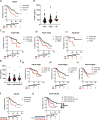Folate receptor 1 is a stemness trait-associated diagnostic and prognostic marker for hepatocellular carcinoma
- PMID: 40038575
- PMCID: PMC11877696
- DOI: 10.1186/s40364-025-00752-8
Folate receptor 1 is a stemness trait-associated diagnostic and prognostic marker for hepatocellular carcinoma
Abstract
Background: Hepatocellular carcinoma (HCC) can be classified into several subtypes based on molecular traits, aiding in prognostic stratification. The subtype with a poor prognosis is often associated with stem/progenitor features. This study focused on identifying circulating biomarkers for aggressive HCC.
Methods: We searched for secretory proteins whose expression was positively associated with the stem/progenitor markers KRT19, EPCAM, and PROM1 in 2 independent HCC cohorts. Serum folate receptor 1 (FOLR1) levels were measured in 238 chronic liver disease and 247 HCC patients, evaluating their diagnostic and prognostic capabilities.
Results: FOLR1 was identified as a secretory protein that was positively correlated with all 3 stem/progenitor markers and a poor prognosis in both the discovery and validation cohorts. Higher FOLR1 expression was detected in tumor than nontumor tissues and was associated with aggressive subtypes, and activation of p53, DNA repair, Myc, E2F, and PI3K/AKT/mTOR pathways. Serum FOLR1 levels correlated with tumoral FOLR1 expression in HCC patients and were significantly elevated compared with those in patients with chronic hepatitis or nonliver disease. Serum FOLR1 levels demonstrated diagnostic performance for HCC comparable to that of alpha-fetoprotein (AFP), and their combination increased the diagnostic accuracy. Elevated serum FOLR1 levels were associated with poor prognosis in HCC patients, regardless of treatment, especially in patients with early-stage disease. The multivariate analysis revealed that the serum FOLR1 level and the Gender, Age, AFP-L3, AFP, and Des-gamma-carboxy prothrombin (GALAD) score were independent predictors of a poor prognosis with their combination further stratifying prognosis.
Conclusions: FOLR1 is a stemness-associated biomarker for HCC, with serum levels serving as a diagnostic marker for HCC and a prognostic indicator for early-stage disease.
Keywords: Biomarker; Diagnosis; FOLR1; HCC; Prognosis.
© 2025. The Author(s).
Conflict of interest statement
Declarations. Ethics approval and consent to participate: This study was conducted in accordance with the Declaration of Helsinki. The validation cohort data were derived from the Thailand Initiative in Genomics and Expression Research for Liver Cancer (TIGER-LC) consortium, which included patients diagnosed with hepatocellular carcinoma (HCC). Institutional Review Board (IRB) approval was obtained from each participating center in Thailand, namely: Maharaj Nakorn Chiang Mai Hospital, Roi Et Hospital, Chulabhorn Hospital-Bangkok, National Cancer Institute of Thailand and Srinagarind Hospital. All participants provided written informed consent. Additionally, this study included a retrospective cohort of patients admitted to Osaka University Hospital (2014–2018) and Hokkaido University Hospital (2007–2018). The study protocol was approved by the Institutional Review Board Committee of Osaka University Hospital (IRB No. 17097). Informed consent was obtained from all patients prior to their participation. The study adhered to ethical guidelines consistent with the principles of the Declaration of Helsinki. Consent for publication: Not applicable. Competing interests: The authors declare no competing interests.
Figures




References
-
- Llovet JM, Kelley RK, Villanueva A, Singal AG, Pikarsky E, Roayaie S, et al. Hepatocellular carcinoma. Nat Rev Dis Primers. 2021;7(1):6. - PubMed
-
- Brown ZJ, Tsilimigras DI, Ruff SM, Mohseni A, Kamel IR, Cloyd JM, et al. Management of hepatocellular carcinoma: a review. JAMA Surg. 2023;158(4):410–20. - PubMed
-
- Rumgay H, Ferlay J, de Martel C, Georges D, Ibrahim AS, Zheng R, et al. Global, regional and national burden of primary liver cancer by subtype. Eur J Cancer. 2022;161:108–18. - PubMed
-
- Marrero JA, Kulik LM, Sirlin CB, Zhu AX, Finn RS, Abecassis MM, et al. Diagnosis, staging, and management of hepatocellular carcinoma: 2018 practice guidance by the American Association for the Study of Liver Diseases. Hepatology. 2018;68(2):723–50. - PubMed
Grants and funding
LinkOut - more resources
Full Text Sources
Research Materials
Miscellaneous

